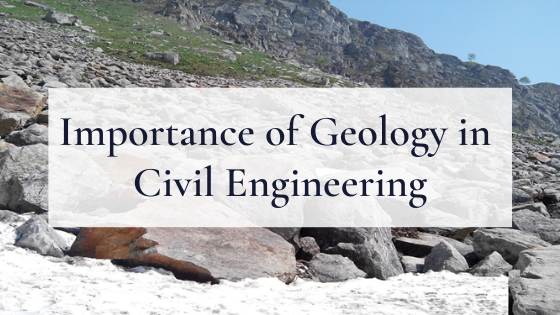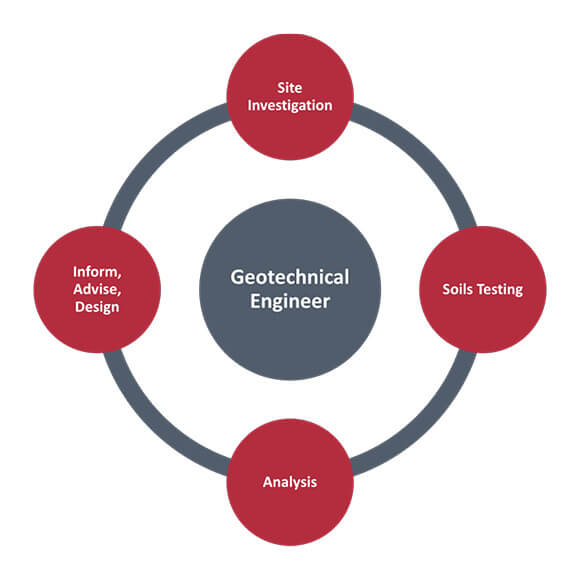Little Known Questions About Geotechnical Engineering For Construction Projects.
8 Simple Techniques For Geotechnical Engineering For Construction Projects
Table of Contents4 Easy Facts About Geotechnical Engineering For Construction Projects ExplainedNot known Factual Statements About Geotechnical Engineering For Construction Projects Not known Details About Geotechnical Engineering For Construction Projects All about Geotechnical Engineering For Construction ProjectsOur Geotechnical Engineering For Construction Projects DiariesSome Of Geotechnical Engineering For Construction Projects
The duty of geotechnical design considerably deals with recognizing the functions of dirt and rock, which may differ considerably by their thickness, wetness web content etc. These features have to be analyzed by geotechnical engineers to forecast their movements under different scenarios. The safety in addition to security of frameworks are impacted by soil conditions, making this analysis needed.A geotechnical engineer will certainly check out soil to identify the bearing capability of the earth and advise correct structure kinds, such as superficial structures, deep structures like stacks, or specialized solutions like floating foundations for soft soils. Comprehending the functions and actions of soil and rock, in addition to how they communicate with building and constructions that have actually been put up on or within them, is one of the primary explanations for why geotechnical engineering is necessary.
Ecological protection is accomplished with geotechnical engineering. Knowledge in air, water, and soil high quality upkeep is placed to make use of by geotechnical designers to minimize the unfavorable impacts of jobs.
Framework development, offshore engineering, tunnel building, and deep foundations. Risk-based layout and multidisciplinary groups. These parts will certainly maintain the area developing and ensure its continued relevance in the years to come. To sum up, geotechnical design is an essential discipline that preserves the strength and honesty of civil infrastructure. Geotechnical engineers add to making building projects effective all over the globe by understanding the behaviour of planet products and using appropriate preparation methods.
The Facts About Geotechnical Engineering For Construction Projects Revealed
By checking out soil, rock, and subsurface conditions, geotechnical engineers supply necessary insights that assist in the design, construction, and upkeep of structures and infrastructure.

Geotechnical Engineering For Construction Projects Fundamentals Explained
Research laboratory testing: Determining the buildings of soil and rock. Area testing: Carrying out tests on-site to examine conditions. Evaluation and style: Utilizing data to develop structures, retaining wall surfaces, passages, and various other structures. A number of top-level building and construction projects have efficiently utilized geotechnical design to guarantee their security and safety and security. For instance:: The globe's highest building called for a deep understanding of the underlying geology.

As a leader in geotechnical engineering, BECC Inc. is committed to supplying ingenious and reliable solutions that fulfill the highest possible requirements of high quality and security. For additional information on exactly how BECC Inc. can sustain your next construction task, call us today and allow us assist you build on strong ground.
William Rankine, an engineer and physicist, created an alternate to Coulomb's earth stress concept. Albert Atterberg established the clay uniformity indices that are still utilized today for dirt classification. In 1885, Osborne Reynolds acknowledged that shearing reasons volumetric dilation of dense materials and contraction of loosened granular products. Modern geotechnical design is claimed to have begun in 1925 with the publication of Erdbaumechanik by Karl von Terzaghi, a mechanical engineer and rock hound.
The Definitive Guide to Geotechnical Engineering For Construction Projects
Terzaghi additionally developed the framework for theories of birthing capacity of foundations, and the theory for prediction of the price of negotiation of click for more info clay layers due to loan consolidation. After that, Maurice Biot fully established the three-dimensional dirt debt consolidation concept, extending the one-dimensional design previously developed by Terzaghi to much more general hypotheses and introducing the set of basic formulas of Poroelasticity.
Geotechnical designers explore and determine the residential More hints properties of subsurface conditions and products. They additionally make equivalent earthworks and keeping structures, tunnels, and framework structures, and might manage and review sites, which may additionally include site monitoring along with the danger assessment and mitigation of natural risks - Geotechnical Engineering for Construction Projects. Geotechnical designers and design geologists perform geotechnical examinations to get info on the physical residential or commercial properties of dirt and rock hidden and adjacent to a site to design earthworks and structures for suggested structures and for the repair work of distress to earthworks and structures triggered by subsurface conditions.
9 Simple Techniques For Geotechnical Engineering For Construction Projects
Geologic mapping and interpretation of geomorphology are normally finished in assessment with a geologist or engineering geologist. Subsurface exploration generally involves in-situ screening (for example, the typical infiltration examination and cone infiltration examination). The excavating of examination pits and trenching (particularly for situating faults and slide planes) may likewise be used to discover soil conditions at depth. Still, they are occasionally utilized to enable a rock hound or designer to be reduced into the borehole for direct aesthetic and manual assessment of the dirt and rock stratigraphy. Various dirt samplers exist to fulfill the requirements of various design projects. The basic infiltration test, which utilizes a thick-walled split spoon sampler, is one of the most typical means to accumulate disturbed samples.

Typically, the user interface's specific geometry is unidentified, and a simplified my site interface geometry is thought. Finite slopes need three-dimensional designs to be assessed, so most slopes are evaluated presuming that they are infinitely vast and can be stood for by two-dimensional designs.
Unknown Facts About Geotechnical Engineering For Construction Projects
The empirical method might be referred to as complies with: General exploration adequate to establish the rough nature, pattern, and homes of deposits. Evaluation of the most possible problems and one of the most unfavorable imaginable variances. Producing the style based upon a functioning hypothesis of behavior prepared for under one of the most likely conditions. Option of amounts to be observed as construction proceeds and computing their anticipated worths based on the working theory under one of the most unfavorable problems.
Measurement of quantities and assessment of actual conditions. Design modification per real conditions The observational technique appropriates for building and construction that has actually already begun when an unexpected development happens or when a failing or accident looms or has currently happened. It disagrees for tasks whose layout can not be changed during construction.